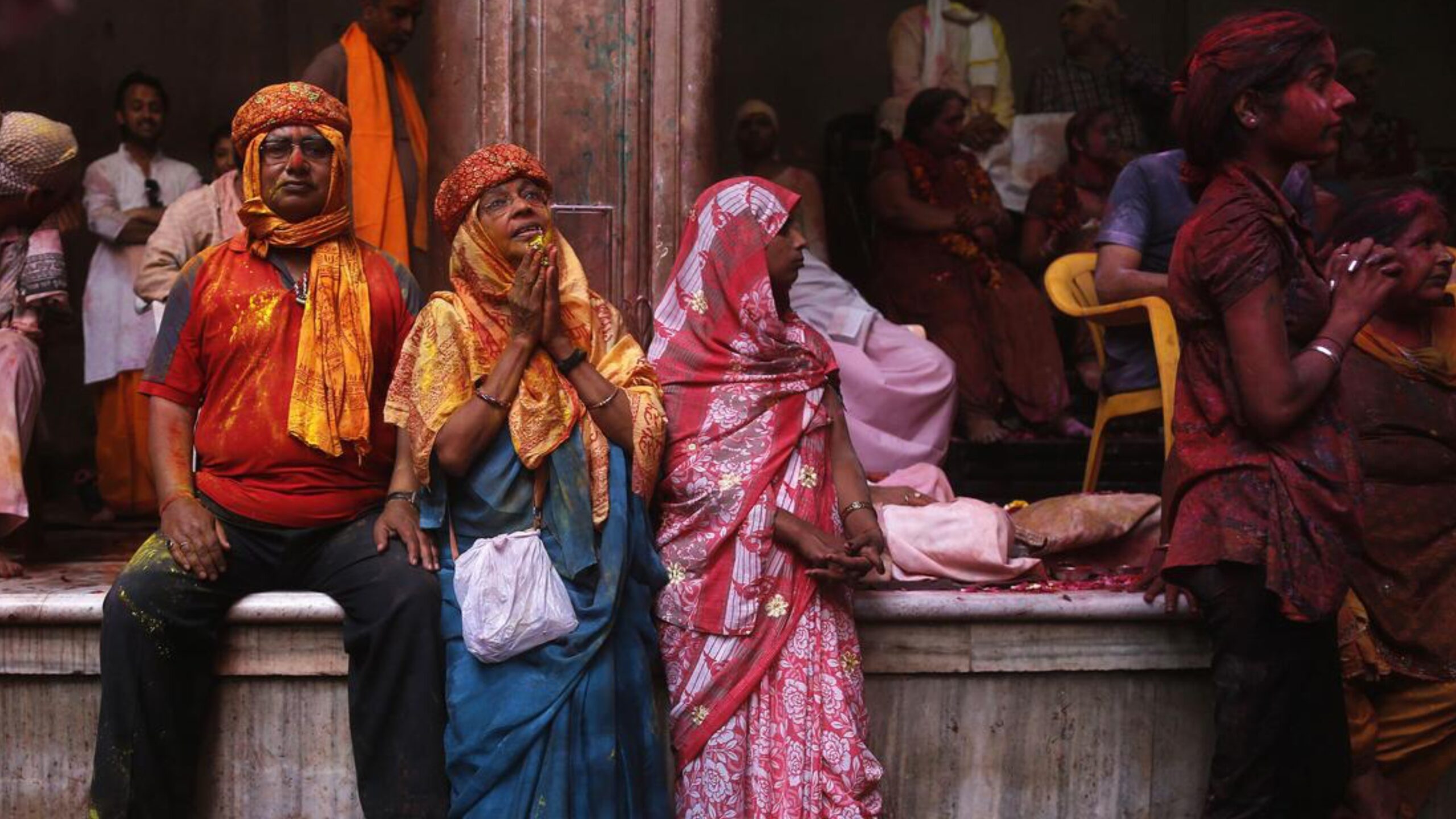The project will ease access for pilgrims to the revered Vrindavan temple – but some residents are wary of the price they will pay.
Devotees at Vrindavan’s Banke Bihari temple during Holi celebrations. | Adnan Abidi/ Reuters
On May 15, the Supreme Court allowed the Uttar Pradesh government to acquire five acres of land around Vrindavan’s Banke Bihari temple for “corridor development”. The court said this project was necessary to compensate for the “lack of infrastructure” that had resulted in two deaths at the shrine during a stampede in 2022.
It was yet another example of an infrastructure project designed for Hindu pilgrims that offers a blend of traditional spirituality and modernity.
Like the Kashi-Vishwanath corridor in Varanasi on which it is modelled, the Banke Bihari corridor has elicited protests from some Vrindavan residents. They say that it ignores the needs of Vrindavan’s residents.
The Banke Bihari corridor project, proposed in 2017 during Adityanath’s first term as Uttar Pradesh chief minister, reflects a push by the state to create a religio-industrial complex shaped by caste Hindu modernity and aesthetics, erasing and rewriting histories and memories of ancient cities.
The project is situated within the Krishna Circuit that connects Mathura, Vrindavan, Govardhan, and Barsana – sites associated with the Hindu god of compassion.
It is part of the Central government’s Rs 3,295.76-crore PRASHAD scheme or Pilgrimage Rejuvenation and Spiritual Augmentation Drive, to “integrate pilgrimage destinations in a prioritised, planned and sustainable manner to provide a complete religious tourism experience”.
To serve this new genre of state-led religious tourism, the institutions of urban planning and development are being harnessed.
New government entities are being formed, such as the Uttar Pradesh Braj Vikas Teerth Parishad. The organisation will prepare “a plan for preserving, developing and maintaining the aesthetic quality” of the heritage of the Braj region in which these sites associated with Krishna are located.
They are assisted at the central, state, and city levels by a host of existing governmental bodies.
Involved with the Krishna Circuit, for instance, are a slew of governmental entities ranging from the Public Works Department, the Yamuna Expressway Industrial Development Authority, the Smart Cities Mission, and the departments of tourism, culture, revenue, forest, irrigation.
This demonstrates how policies and offices intended for urban development have been co-opted by state-run religious tourism projects.
The promises made by the Banke Bihari Corridor project are far-reaching. The plan proposes to widen Vrindavan’s historic “kunj galiyan” – the narrow lanes around the Banke Bihari Temple that the faithful believe were once walked by Krishna.
It plans to link the Yamuna riverfront to the temple through new access routes, commercial corridors and expansive parking hubs.
The Uttar Pradesh government has allocated Rs 500 crores for the development of the Banke Bihari corridor.
The Supreme Court in May had permitted the fixed deposits of the Banke Bihari Temple Trust to be used to acquire 5 acres of land around the shrine. But early in August, a bench of the court had criticised the Uttar Pradesh government for acting in a “clandestine manner” to secure permission to use temple funds for a corridor project through an application in a civil dispute.
The project is set to displace over 300 buildings, impacting long-standing residents and shopkeepers.
The plan for the region envisages massive networks of highways and apartment complexes such as Raya Heritage City led by the Yamuna Expressway Industrial Development Authority on fertile farmland.
This is likely to drive up land prices around Vrindavan and attract buyers from larger cities and NRIs seeking a second home closer to the deity – changing the pattern of land ownership in the city.
The Banke Bihari Corridor plan has not been without controversy. In June, hundreds of members of the Goswami community locked their homes and shops to protest plans for the corridor around the temple.
Women of the community wrote letters in blood to Adityanath and Prime Minister Narendra Modi, angered that the ownership and governance of the temple will be transferred from their hereditary lineage to another trust.
Some of that discontent was evident in 2022, when we visited Vrindavan.
Several shopkeepers were anxious about potentially being dislocated by the Banke Bihari corridor, just like the counterparts had been for the project in Varanasi: the Kashi Vishwanath corridor resulted in the demolition of more than 300 houses.
A significant concern related to the uncertainty around ownership documents.
Some shopkeepers feared for their livelihoods because they rented their spaces. While the owners of the structures would receive compensation, it was not clear what the shopkeepers would receive – if anything at all.
Others pointed out that many of the occupants had been there for generations but lacked formal documents, as is the case in many places in India.
The area is now characterised by narrow pathways, homes, shops, and traditional, informal economies driven by vendors, shopkeepers, traders, artisans, widows, and beggars.
This will be replaced by wider lanes, broader roads for motorised vehicles, parking facilities, greenfield expressways, and riverfront promenades on the floodplains.
This will transform Vrindavan’s ancient, messy cityscape into a sanitised, consumable site.
It will lead to a complete spatial reconfiguration of the region driven by the Smart City mission – the government’s “urban renewal and retrofitting programme” that aims to make cities “citizen-friendly and sustainable”.
However, as critics have noted, this initiative involves top-down decisions, large infrastructure projects, and using digital technologies in governance. But the authorities have not considered whether long-time residents need this infrastructure, who will be displaced and who will benefit.
Nishita Banerjee is a qualitative researcher at a media platform based in Noida, with academic training in sociology from Ambedkar University Delhi.
Krishanu is an independent researcher based in Delhi, working on issues of urban governance, mobility, and culture.
Pavithra Chandrasekar is an independent researcher and writer based in Bengaluru, focusing on land, climate, and energy.
This article is the second in a series on 10 years of the Smart Cities Mission, curated for Scroll by the Centre for Financial Accountability. It was originally published in Scroll, and you can read here.
Centre for Financial Accountability is now on Telegram and WhatsApp. Click here to join our Telegram channel and click here to join our WhatsApp channel, and stay tuned to the latest updates and insights on the economy and finance.


